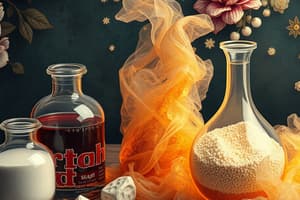Podcast
Questions and Answers
What are the 2 classes of matter?
What are the 2 classes of matter?
- Compound
- Element
- Mixture (correct)
- Pure Substance (correct)
What is a mixture?
What is a mixture?
A blend of 2 or more substances not chemically combined.
What is a pure substance?
What is a pure substance?
A substance made up of only one type of particle; an element or compound.
What is an element?
What is an element?
What is a compound?
What is a compound?
What are types of mixtures?
What are types of mixtures?
What is a homogeneous mixture?
What is a homogeneous mixture?
What is a heterogeneous mixture?
What is a heterogeneous mixture?
Name 3 sub-types of mixtures.
Name 3 sub-types of mixtures.
What is a solution mixture?
What is a solution mixture?
What does aqueous mean?
What does aqueous mean?
What is a suspension mixture?
What is a suspension mixture?
What is a colloid mixture?
What is a colloid mixture?
How do you identify a solution?
How do you identify a solution?
How do you identify a colloid?
How do you identify a colloid?
How do you identify a suspension?
How do you identify a suspension?
Flashcards are hidden until you start studying
Study Notes
Classes of Matter
- Matter is categorized into two main classes: mixtures and pure substances.
Mixtures
- Mixture: A blend of two or more substances that are not chemically combined.
- Mixtures can be separated using physical methods, allowing individual substances to retain their properties.
Pure Substances
- Pure substance: Composed solely of one type of particle, which can be either an element or a compound.
Elements
- Element: The basic building block of matter, represented by a unique chemical symbol—each element consists of one type of atom.
Compounds
- Compound: Formed by the chemical combination of two or more elements in a specific ratio. Examples include water (H2O) and hydrogen peroxide (H2O2).
Types of Mixtures
- Mixtures can be classified into homogeneous and heterogeneous types.
Homogeneous Mixture
- Homogeneous mixture: Uniform composition throughout, with components evenly distributed.
Heterogeneous Mixture
- Heterogeneous mixture: Non-uniform composition where different components can be distinguished visually.
Sub-types of Mixtures
- Three sub-types of mixtures include:
- Solution
- Suspension
- Colloid
Solution Mixture
- Solution: A homogeneous mixture where a solute (small particles) dissolves in a solvent (the substance that dissolves the solute).
Aqueous Solutions
- Aqueous solution: A solution in which water serves as the solvent.
Suspension Mixture
- Suspension: A heterogeneous mixture with larger particles that settle when left undisturbed. Examples include salad dressing, ketchup, and peanut butter.
Colloid Mixture
- Colloid: A mixture with medium-sized particles that remain suspended without settling, exhibiting properties of both homogeneous and heterogeneous mixtures. Examples include juice, milk, and hair conditioner.
Identifying Mixtures
- Solution: Clear and transparent, allowing light to pass through.
- Colloid: Cloudy and translucent, causing light to scatter.
- Suspension: More opaque and cloudy, preventing light from passing through.
Studying That Suits You
Use AI to generate personalized quizzes and flashcards to suit your learning preferences.




